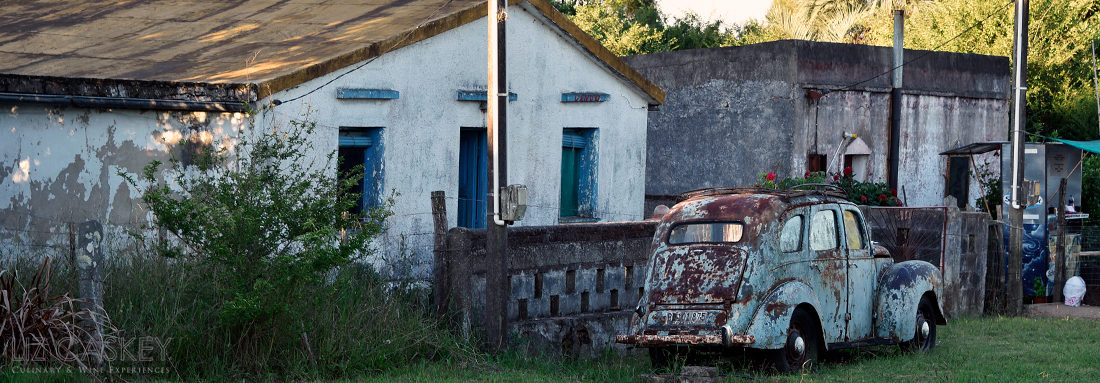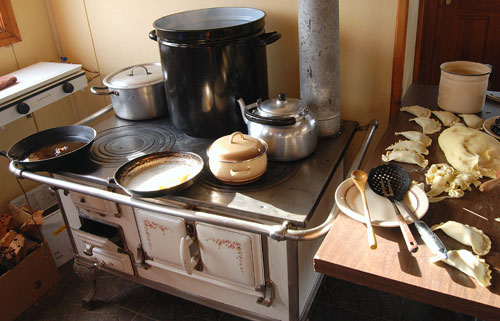
The first of September begins to wake Chileans from their deep sleep of winter hibernation. The weather turns spring like with orchards blooming in an array of white and pink blossoms. The days get longer, the sun warmer. The hills are emerald green and the Andes gleaming with fresh snow and birds chirping. And ahhh, the smell of steak grilling and baked empanadas being hawked on nearly every corner.
I always associate the special scent of grilled meat and the aromatic pino, beef filling, with the nearing of El Dieciocho, Chilean Independence Day. Commemorating Chile’s rupture from Spain on September 18, 1810, today, the holiday has extended to a monthlong celebration Chilean traditions: dances like the flirty, folkloric cueca; rodeos with cowboys in wide-rimmed flat-top straw hats adorned with elegant ponchos; rustic music; non-stop barbecues; and dozens of empanadas scarfed down with red wine.
While empanadas are around most of the year, the temptation inundates you throughout September. This morning, I woke up with a hankering for them just knowing it was September. Thinking back, I remembered some of the best empanadas I recently have nibbled in Chile in a far flung corner near Puerto Natales, at the end of the continent, miles and miles from civilization. The only neighbors–the Torres del Paine. One snowy night, we arrived at Estancia Tercera Barranca, and were greated by Pepe, the owner who promptly introduced us to Carmen, their wonderful cook.
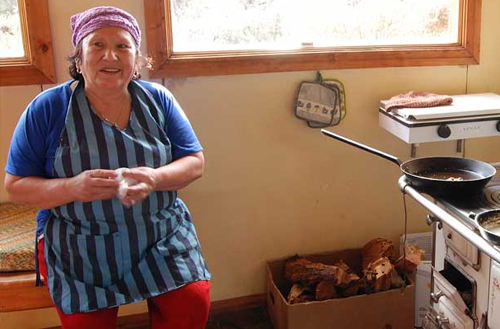
The next morning, we arose to views of the Torres before another snow storm set in, this time while on horse back. We turned back, arriving frostbitten and starving, to the warmth of Carmen’s cocina económica, a humble yet efficient wood burning stove. The stove had a magnetic warmth to it and I couldn’t seem to part its company. While I warmed up, she quietly went about making classic empanadas de pino, meat empanadas, but fried, not baked, as I usually have them. As I stood there sipping my aguita, herbal tea, and rubbing my hands over the warm fire, she explained to me the secret to a crunchy dough: lard. And in all seriousness she looked at me and said, “not the commercial stuff”. She meant unprocessed pig fat. Oh yeah.
I studied in silence as she pulled off golf-sized balls, rolled them out, and stuffed them with the cumin and paprika tinged meat stuffing. She studded the filling with black olives, golden raisins, nestled hard-boiled egg slices, folded them over, and crimped the edges. Literally, clocked at 30 seconds each. An empanada maestra.
The dough was outstanding–flavorful, light, and crisp. The filling was intense and caldúa, soupy. Perhaps it was the remoteness of the place, the cold day, the cozy feeling as the snow fell peacefully around us, and Carmen’s inviting way, but these celestial empanadas were the vision of my perfect meal. Like little steaming pockets of love. Now to share the recipe so you can recreate them at home too.
Stuffing:
4 tablespoons vegetable oil, divided
2 ¼ pounds (1 kilogram) beef fillet, ground or chopped in ½ inch/1 cm cubes
Sea salt to taste
1 teaspoon cumin
1 teaspoon chili sauce (Substitute: hot sauce)
4 large onions, chopped
2 tablespoons paprika
½ teaspoon black pepper
20 black olives
40 golden raisins, soaked in hot water
4 hard boiled eggs, peeled and cut into eighths
Dough:
6 cups all-purpose flour
2 teaspoons baking powder
2 teaspoons salt
2 cups warm water
1/2 cup lard (or vegetable shortening) at room temperature
4 cups vegetable oil for frying
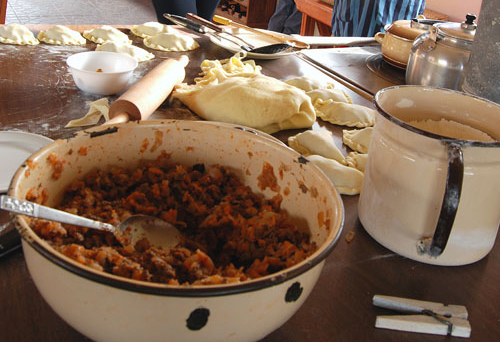
Stuffing:
Heat 2 tablespoons of the oil in large sauce pan. Add the beef fillet and sauté for about 3-4 minutes. The beef should be undercooked. Remove from heat. In a separate bowl, season the beef with salt to taste, cumin, and chili sauce (optional). Reserve.
Return the pan to the heat and add the remaining 2 tablespoons of oil. Add the chopped onions and cook until transparent and golden, about 10-15 minutes. Season with salt to taste, the paprika, and black pepper. Combine the onion mixture with the reserved meat. Refrigerate for at least an hour before filling dough so that the mixture’s juices solidify.
Dough:
On a clean work surface, combine the flour with the salt and baking powder. Form a well in the center and add the warm water and lard. Using your hands, bring together to obtain a soft, pliable dough, adding flour as necessary. The dough should be elastic. Knead lightly for a few minutes.v After forming the dough, cover with a kitchen towel and let cool/rest for thirty minutes.
On a lightly floured surface, pull off medium ball-sized portions and roll out the dough to 1/8-inch thickness. (Note: many Chilean cooks use a pasta machine for this step). Use a cutter or a round plate to cut out 6-inch (15 centimeters) wide circles, pressing around the circumference with a sharp knife. Gather up the dough scraps and continue to roll out until all the dough has been used.
Place two heaping tablespoons of the stuffing in the middle of the dough circle leaving a 1/2 inch (1 centimeter) margin. Nestle a piece of hard boiled egg, an olive, and two raisins in the stuffing. Brush the edges with warm water and fold the dough in half to tightly cover the filling. Pressing the edges together and around the filling to press out any air bubbles. Crimp the edges to seal.
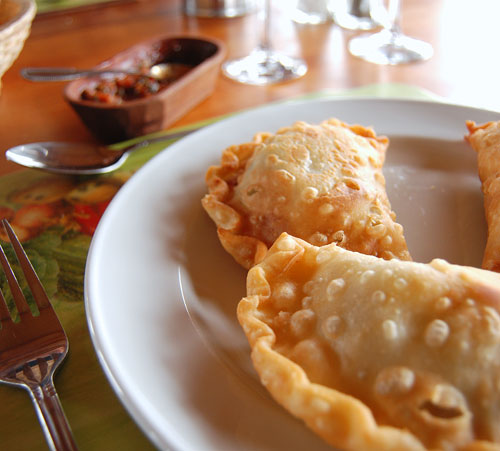
Drain from oil and let cool for 5 minutes before eating. This is a warning from personal experience resulting in scalded taste buds on many occasions. Remember the filling is soupy and will be steaming!
Makes approximately 20 6-inch empanadas.
